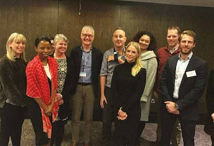Spotlight on… the frailty improvement programme at Barts Health

We explore how staff from across St Bartholomew’s Hospital worked together to make care for TAVI patients safer and more effective.
What’s the frailty improvement programme?
Launched in September 2018, the frailty improvement programme set out to improve the experiences of cardiac patients at St Bartholomew’s by reviewing how frailty indicator scores are applied throughout their time in hospital.
When frail older patients are admitted to hospital, they're at risk of a number of adverse events, such as falls, delirium and disability. Applying a frailty score to each patient is a practical way of assessing their level of risk and helping to avoid events which might cause them unnecessary harm or lengthen their stay.
The programme is part of a wider piece of work by the Specialised Clinical Frailty Network (SCFN) and supported by NHS Elect.
Which patients’ scores were looked at?
The team focussed on patients visiting the hospital to have a TAVI.
TAVI – short for trans-catheter aortic valve implantation - is a procedure to replace a narrowed heart valve by implanting a man-made replacement.
More than 400 TAVIs are carried out at St Bartholomew's Hospital each year – typically on patients who are too old and too frail to have conventional heart surgery.
A high proportion of patients undergoing TAVI are over the age of 75, have a number of comorbidities and score highly on frailty indicators – putting them more at risk of complications.
What did the team want to achieve?
The team undertook a review of how frailty scores were used throughout the TAVI patients’ journey with the aim of reducing the number of days a patient stays in hospital, improving their 30-day and one-year mortality rates and enhancing their overall experience pre and post-procedure.
And how did they do it?
The team took a quality improvement (QI) approach to the programme. QI methodology recognises that staff are best placed to identify areas for improvement and to find lasting solutions, often working in partnership with patients.
One of the major advantages to using QI methodology is that it helps to ensure that improvements are successful and sustainable, rather than just short-term fixes.
What did the team change?
Firstly, by using the Rockwood Frailty Assessment Tool, the team ensured that all TAVI patients are assessed for their frailty score before their procedure.
The team then focussed on making sure this score is communicated to every member of staff involved in that patient’s care, from start to finish.
To do this required engagement with the entire multidisciplinary team, so input was sought from medical, advanced nursing and therapy team members.
The TAVI team is currently seeking to extend this to include geriatrician and polypharmacy input.
What did the programme achieve?
By increasing understanding of clinical frailty scores amongst staff, the team has improved the way that frail patients are identified, meaning that effective, person-centred treatments can be sought much sooner, for those who need it.
Discussions with physiotherapy and occupational therapy leads has helped to reduce the number of referrals to therapy services.
By using the Rockwood Frailty Assessment Tool, patients with greater levels of frailty are referred for a comprehensive geriatric assessment.
What about the patient experience?
Preliminary data of 59 inpatients revealed that more than 93% of TAVI patients were happy with the admission process.
On preparing for discharge, 91% were satisfied with their experience.
Significantly, length of stay for TAVI admissions has been reduced from three days to two.
By reducing time in hospital for patients with mild or little frailty, there is now more capacity to create patient-tailored interventions for the group of patients with more complex needs.
Two clear TAVI pathways have now been developed, meaning that more patient care is better suited to individual needs.
What’s next?
The next steps for the team are to address frailty at the beginning of the TAVI patient pathway at their provider hospital.
Research has shown that patients wait longest for investigations after their initial assessment in clinic.
Using this wait to address some of their frailty issues would help to reduce the number of complications further down the pathway.
On some occasions, patients are waiting in provider hospitals for transfer to St Bartholomew’s for assessment and TAVI.
A large amount of bed rest pre-procedure can affect a patient's recovery post-procedure, so the team is keen to link with provider hospitals who have patients waiting to be transferred to St Bartholomew’s to minimise the effects of patient de-conditioning.
WeImprove is our approach to quality improvement. It provides a clear and methodical way to make improvements that really matter to you.
Find out more on WeShare here.
Read the full programme report here*
*This report was authored by:
Darren Barnes, registered nurse. DIP.HE, BSc (Hons), MSc
Simon Waller, registered nurse. BSc (Hons), MSc
Melanie Jerrum, TAVI clinical nurse specialist. LLB. MSc.
Helen Queenan, TAVI clinical nurse specialist. BSc.
Kerry Bedford, TAVI clinical nurse specialist. DIP.HE . BSc
